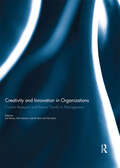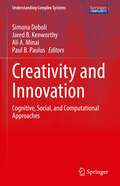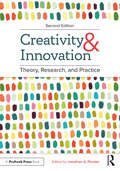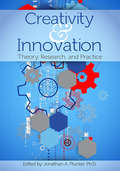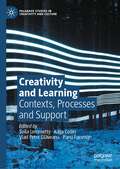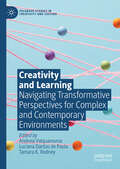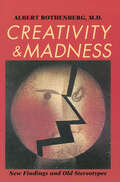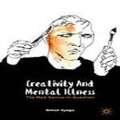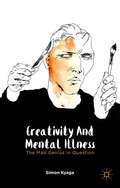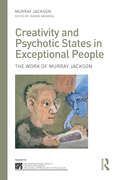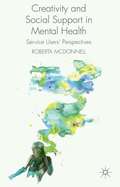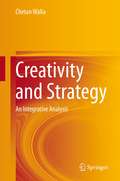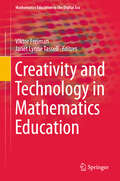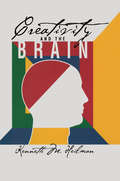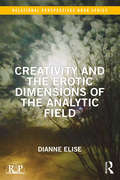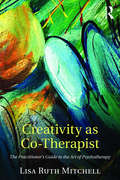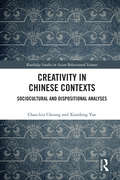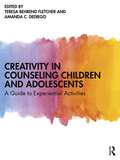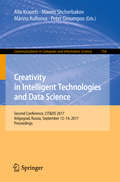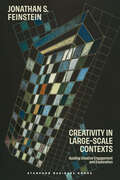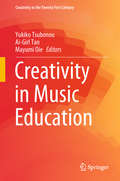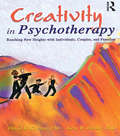- Table View
- List View
Creativity and Innovation in Organizations (SIOP Organizational Frontiers Series)
by Michael D. Mumford E. Michelle ToddThis volume presents a distinctly multilevel perspective on creativity and innovation that considers individual-level, team-level, and firm-level factors. In illustrating these factors, this volume presents both theoretical and practical implications to guide researchers and practitioners alike in the continued study and advancement of creativity and innovation in organizations. Chapter authors not only discuss the abilities, personality, and motivational attributes that contribute to employee creativity, but they also address the impact of leadership and climate on creative performance in teams. Subsequently, firm-level influences such as planning, learning, strategy, and professions that influence the success of creative and innovative efforts are examined. With contributions from leading scholars around the globe, this book offers a comprehensive review of creativity and innovation to assist researchers and practitioners in their quests to understand and improve organizational creativity and innovation. This is an essential resource for scholars, researchers, or graduate students interested in creativity, innovation, and organizational behavior.
Creativity and Innovation in Organizations: Current Research and Recent Trends in Management
by José Ramos, Neil Anderson, José M. Peiró and Fred ZijlstraThis book reflects on the increasing variety of perspectives in organizational innovation research, paying attention to the antecedents, but also to the outcomes, of innovation. Some chapters analyze the ‘dark side’ of innovation, including the potential negative consequences of innovative behaviors, or of defying the innovation maximization fallacy. Others explicitly consider affective responses after innovation efforts, and assume that positive or negative effects rely on the context in which innovations occur, and on the way in which people manage the process of innovation. Several contributions adopt the dialectic approach by considering the multiple pathways and mechanisms that could lead to innovation at organizations. Most of the chapters include the interaction of actors’ characteristics (from employees or teams) together with situational constraints from the task or the social context, and outline the relevance of processes like team learning; motivation variables like basic need satisfaction; congruence of motives or meaningfulness at work; dynamics of communication networks; and affective variables. This edited collection offers a rich picture of current research and management trends in the field and contributes constructively toward promoting the dialectic perspective on creativity and innovation in the workplace. This book was originally published as a special issue of the European Journal of Work and Organizational Psychology.
Creativity and Innovation: Cognitive, Social, and Computational Approaches (Understanding Complex Systems)
by Ali A. Minai Paul B. Paulus Simona Doboli Jared B. KenworthyThis book focuses on the emergence of creative ideas from cognitive and social dynamics. In particular, it presents data, models, and analytical methods grounded in a network dynamics approach. It has long been hypothesized that innovation arises from a recombination of older ideas and concepts, but this has been studied primarily at an abstract level. In this book, we consider the networks underlying innovation – from the brain networks supporting semantic cognition to human networks such as brainstorming groups or individuals interacting through social networks – and relate the emergence of ideas to the structure and dynamics of these networks. Methods described include experimental studies with human participants, mathematical evaluation of novelty from group brainstorming experiments, neurodynamical modeling of conceptual combination, and multi-agent modeling of collective creativity. The main distinctive features of this book are the breadth of perspectives considered, the integration of experiments with theory, and a focus on the combinatorial emergence of ideas.
Creativity and Innovation: Theory, Research, and Practice
by Jonathan A. PluckerCreativity and innovation are frequently mentioned as key skills for career and life success in today’s world. This award-winning book brings together some of the world's best thinkers and researchers to offer insights on creativity, innovation, and entrepreneurship. The new edition features fully updated chapters, including expanded coverage of exciting topics such as group creativity, ethics, development, makerspaces, and lessons from other fields. Educational applications are emphasized throughout. Creativity is often the spice of life, that little extra something that makes the mundane into the interesting, making our routines into fresh new approaches to our daily lives. With this book’s comprehensive and readable approach, you’ll be able to understand what creativity truly is (and isn't), how to foster it, and how it relates to intelligence, leadership, personality, and other concepts.
Creativity and Innovation: Theory, Research, and Practice
by Jonathan PluckerCreativity and innovation are frequently mentioned as key 21st-century skills for career and life success. Indeed, recent research provides evidence that the jobs of the future will increasingly require the ability to bring creative solutions to complex problems. And creativity is often the spice of life, that little extra something that makes the mundane into the interesting, making our routines into fresh new approaches to our daily lives. Over the past quarter century, our understanding of creativity has advanced significantly-we know more about what it is (and isn't), we better understand how to foster it, and we have deeper, more complex knowledge about how it relates to intelligence, leadership, personality, and other constructs. This book brings together some of the world's best thinkers and researchers on creativity, innovation, and entrepreneurship to provide a comprehensive but highly readable overview of these exciting, important topics.
Creativity and Learning: Contexts, Processes and Support (Palgrave Studies in Creativity and Culture)
by Vlad Petre Glăveanu Soila Lemmetty Kaija Collin Panu ForsmanThis book focuses on the relations and connections between creativity and learning in different contexts. By shifting the focus from individual psychology to a sociocultural framework, it explores the multidimensional nature of the processes under study, resulting in a ‘bigger picture’ of creativity and learning and their interdependence. The book examines the sociocultural definitions of creativity and learning in the contexts of children’s education and adult education, as well as workplaces and organisations. It offers insights concerning the frameworks and practices developed to enhance creativity and learning in different applied contexts. This collection brings together experts from across the globe and combines theoretical understandings, recent empirical findings and practical tools to be used by researchers, students and teaching staff, as well as practitioners, educators and managers. The book is a comprehensive, research-based volume on creativity and learning and their dynamic interconnection in various spheres of our life.
Creativity and Learning: Navigating Transformative Perspectives for Complex and Contemporary Environments (Palgrave Studies in Creativity and Culture)
by Andreia Valquaresma Luciana Dantas de Paula Tamara K. RodneyThis book brings together transformative perspectives on creative education. Creativity, creative education and pedagogy are not exempt from the impact of the complexities of our world. In fact, there seems to be an increasing demand for designing learning environments that are more able to support multiple modes of (inter)acting with the other and the world. It is a mandate of our time to increase learning opportunities in socioculturally diverse contexts. In this light, this book examines how creativity is shaped by sociocultural factors, and how it can be pivotal in challenging dominant narratives and entrenched pedagogies. Drawing on a diverse range of conceptual and practice-oriented chapters that include voices from the Global North and the Global South, this edited collection offers a pragmatic analysis of how the future of creativity in education could be shaped. Ultimately, it seeks to contribute to an understanding of creativity as a necessary tool for social transformation and the recognition that this transformation happens in multiple spheres. A thought-provoking analysis of how the future of creativity in education could be shaped to promote equitable learning environments, this is an ideal resource for creatives, academics, and students in the fields of education, psychology, and pedagogy, as well as practitioners and professionals interested in implementing creative diversity in education.
Creativity and Madness: New Findings and Old Stereotypes
by Albert RothenbergIntrigued by history's list of "troubled geniuses,"Albert Rothenberg investigates how two such opposite conditions—outstanding creativity and psychosis—could coexist in the same individual. Rothenberg concludes that high-level creativity transcends the usual modes of logical thought—and may even superficially resemble psychosis. But he also discovers that all types of creative thinking generally occur in a rational and conscious frame of mind, not in a mystically altered or transformed state.Far from being the source—or the price—of creativity, Rothenberg discovers, psychosis and other forms of mental illness are actually hindrances to creative work. Disturbed writers and absent-minded professors make great characters in fiction, but Rothenberg has uncovered an even better story—the virtually infinite creative potential of healthy human beings.
Creativity and Mental Illness
by James C. KaufmanAre creative people more likely to be mentally ill? This basic question has been debated for thousands of years, with the 'mad genius' concept advanced by such luminaries as Aristotle. There are many studies that argue the answer is 'yes', and several prominent scholars who argue strongly for a connection. There are also those who argue equally strongly that the core studies and scholarship underlying the mad genius myth are fundamentally flawed. This book re-examines the common view that a high level of individual creativity often correlates with a heightened risk of mental illness. It reverses conventional wisdom that links creativity with mental illness, arguing that the two traits are not associated. With contributions from some of the most exciting voices in the fields of psychology, neuroscience, physics, psychiatry, and management, this is a dynamic and cutting-edge volume that will inspire new ideas and studies on this fascinating topic.
Creativity and Mental Illness
by Simon KyagaIs there really a thin line between madness and genius? This book provides a thorough review of the current state of knowledge on this age old idea, and presents new empirical research to put an end to this debate, but also to open up discussion about the implications of its findings.
Creativity and Mental Illness: The Mad Genius in Question
by S. KyagaIs there really a thin line between madness and genius? This book provides a thorough review of the current state of knowledge on this age old idea, and presents new empirical research to put an end to this debate, but also to open up discussion about the implications of its findings.
Creativity and Psychotic States in Exceptional People: The work of Murray Jackson (The International Society for Psychological and Social Approaches to Psychosis Book Series)
by Murray JacksonCreativity and Psychotic States in Exceptional People tells the story of the lives of four exceptionally gifted individuals: Vincent van Gogh, Vaslav Nijinsky, José Saramago and John Nash. Previously unpublished chapters by Murray Jackson are set in a contextual framework by Jeanne Magagna, revealing the wellspring of creativity in the subjects’ emotional experiences and delving into the nature of psychotic states which influence and impede the creative process. Jackson and Magagna aim to illustrate how psychoanalytic thinking can be relevant to people suffering from psychotic states of mind and provide understanding of the personalities of four exceptionally talented creative individuals. Present in the text are themes of loving and losing, mourning and manic states, creating as a process of repairing a sense of internal damage and the use of creativity to understand or run away from oneself. The book concludes with a glossary of useful psychoanalytic concepts. Creativity and Psychotic States in Exceptional People will be fascinating reading for psychiatrists, psychotherapists and psychoanalysts, other psychoanalytically informed professionals, students and anyone interested in the relationship between creativity and psychosis.
Creativity and Social Support in Mental Health
by Roberta McdonnellThis book weaves together service users' lived experiences of mental health recovery and ideas about how creative activities such as art, music, and creative reading and writing can promote it, particularly within social and community settings.
Creativity and Strategy: An Integrative Analysis
by Chetan WaliaThis book provides an integrative analysis of creativity and strategic practices, particularly strategic problem formulation and strategic decision making. It examines the decision and not the individual as a unit of analysis, which leads to a deeper understanding of creative outcomes. It draws a correlation between strategic intent and creative outcomes, both positive and negative, and provides an integrated framework for understanding creativity. Finally, the book develops a creative strategic framework and draws conclusions for the practice of management and for future research.
Creativity and Technology in Mathematics Education (Mathematics Education in the Digital Era #10)
by Viktor Freiman Janet Lynne TassellThis volume provides new insights on creativity while focusing on innovative methodological approaches in research and practice of integrating technological tools and environments in mathematics teaching and learning. This work is being built on the discussions at the mini-symposium on Creativity and Technology at the International Conference on Mathematical Creativity and Giftedness (ICMCG) in Denver, USA (2014), and other contributions to the topic. The book emphasizes a diversity of views, a variety of contexts, angles and cultures of thought, as well as mathematical and educational practices. The authors of each chapter explore the potential of technology to foster creative and divergent mathematical thinking, problem solving and problem posing, creative use of dynamic, multimodal and interactive software by teachers and learners, as well as other digital media and tools while widening and enriching transdisciplinary and interdisciplinary connections in mathematics classroom. Along with ground-breaking innovative approaches, the book aims to provide researchers and practitioners with new paths for diversification of opportunities for all students to become more creative and innovative mathematics learners. A framework for dynamic learning conditions of leveraging mathematical creativity with technology is an outcome of the book as well.
Creativity and the Brain
by Kenneth M. HeilmanIn Creativity and the Brain, Kenneth Heilman explores the possible brain mechanisms which underlie creativity, by reviewing the existing evidence and putting forward new ideas. On the way, he discusses the relationships between creativity and intelligence, brain anatomy, neuropharmacology, addiction, handedness, sex differences, and mood states such as depression. He also addresses the effects of neurological disorders and aging, as well as the influence of environmental factors such as tolerance and nurturing.The book will be of interest to neuroscientists, psychologists, psychiatrists, neurologists and educators The engaging and succinct style of this book also make it appealing to students, and researchers from a variety of disciplines who have an interest in understanding the brain mechanisms underlying creativity.
Creativity and the Erotic Dimensions of the Analytic Field (Relational Perspectives Book Series)
by Dianne EliseCreativity and the Erotic Dimensions of the Analytic Field centers on the mutually reinforcing relationship between erotic and creative energies. Erotic embodiment is given context within a contemporary model of clinical process based in analytic field theory and highlighting Winnicott. Dianne Elise uses clinical material to bring theory alive, giving clinicians an explicit picture of how they might utilize the ideas presented. In a fascinating return to Freud’s emphasis on libido and Eros, a creative mind is seen as located within a libidinal connection to the erotic body. The erotic is underscored as an important ingredient of the clinical situation—a lively spontaneity that partakes of the analyst’s as well as the patient’s creative self, vitalizing the field of clinical engagement. A full formulation of the analytic field must include awareness of the centrality of the erotic in the maternal matrix, in ongoing development, and in the clinical setting. The erotic-aesthetic dimension of the mind potentiates the creative interplay of the analytic process. Written in an engaging and accessible style, this original contribution makes complex theory available to psychoanalytic clinicians at all levels, and to a wide range of readers, while offering sophisticated theoretical and clinical innovations. Elise addresses the need to engage multiple aspects of erotic life while maintaining a reliable professional boundary.
Creativity as Co-Therapist: The Practitioner's Guide to the Art of Psychotherapy
by Lisa MitchellIn Creativity as Co-Therapist, experienced psychotherapist and creativity expert, Lisa Mitchell, bridges the gap between theoretical knowledge and therapeutic application by teaching psychotherapists of all backgrounds to see therapy as their art form. Readers are guided through the five stages of the creative process to help them understand the complexities of approaching their work creatively and to effectively identify areas in which they tend to get stuck when working with clients. Along the way workbook assignments, case studies, personal stories, and hands-on art directives will inspire the reader to think outside the box and build the creative muscles that hold the key to enlivening their work.
Creativity at Work: A Festschrift in Honor of Teresa Amabile (Palgrave Studies in Creativity and Innovation in Organizations)
by Colin M. Fisher Roni Reiter-Palmon Jennifer S. MuellerThis book brings together leading scholars in the field of creativity to provide an overview and examination of the work of Teresa Amabile, a pioneer of research on organizational creativity. The authors explore Dr. Amabile’s contributions to the modern study of creativity in organizations and her influence on current research. Further, they also reflect on how her work might be used to advance future research, particularly in the areas of componential theory and its extension as well as the consensual assessment technique. The contributors include both eminent and emerging scholars and their diverse backgrounds can be seen to reflect the breadth of the impact of Teresa Amabile’s work across the areas of the social psychology of creativity, creativity measurement, and application of this knowledge to understanding creativity and innovation in the workplace. This book will provide an invaluable resource to students and scholars of social psychology, creativity studies, industrial and organizational psychology, business and management.
Creativity in Chinese Contexts: Sociocultural and Dispositional Analyses (Routledge Studies in Asian Behavioural Sciences)
by Xiaodong Yue Chau-kiu CheungExamining creativity in Chinese societies from both a personal and contextual standpoint, this ground-breaking book offers readers a unique insight into the Chinese mind. It provides a review of the nature, origins, and consequences of creativity, deriving from empirical evidence in the Chinese context. Specifically, the book unravels the conceptualization of creativity and its relationships with various demographic and dispositional factors in Chinese societies. The book proceeds to give readers an understanding of how creativity maintains reciprocal relationships with various forms of well-being. The content of the book brings together empirical evidence and theory grounded on Chinese societies to offer researchers and students a unique realistic view of the nature of creativity there. This book will be a must read for any researcher or practitioner interested in this fascinating topic.
Creativity in Counseling Children and Adolescents: A Guide to Experiential Activities
by Teresa Behrend FletcherCreativity in Counseling Children and Adolescents shows counselors and other mental health professionals how to use a wide variety of creative and experiential activities that emphasize strengths and skills-focused work. The first section addresses the basic tenets of experiential learning, guiding readers through ways to build a creative and interactive environment for counseling. Later chapters lay out methods for choosing activities and finding the right match between diverse interests, skills, abilities, and cultural considerations. Once an activity is identified and implemented, the book shows counselors how to help children make meaning and capitalize on the benefits of the activity through processing and transferring skills.
Creativity in Intelligent Technologies and Data Science: Second Conference, CIT&DS 2017, Volgograd, Russia, September 12-14, 2017, Proceedings (Communications in Computer and Information Science #754)
by Alla Kravets Maxim Shcherbakov Marina Kultsova Peter GroumposThis book constitutes the refereed proceedings of the First Conference on Creativity in Intelligent Technologies and Data Science, CIT&DS 2015, held in Volgograd, Russia, in September 2015. The 66 revised full papers and two short papers presented were carefully reviewed and selected from 208 submissions. The papers are organized in topical sections on computational creativity for science and design; knowledge discovery in patent and open sources for creative tasks; software computer-aided design and agent-based systems; conceptual, cognitive and qualitative modeling with application in intelligent decision making; design creativity in CAD/CAM/CAE/PDM; intelligent decision support for continual improvement process; data science in energy management, transportation and urban development; data science in social networks analysis; natural language and image processing and analysis; game-based learning technologies in engineering education and educational games design; personalized learning in Web-based intelligent educational systems; e-inclusion: development of smart mobile applications for people with disabilities.
Creativity in Large-Scale Contexts: Guiding Creative Engagement and Exploration
by Jonathan S. FeinsteinA new model for smarter creativity Innovators and creators work in cultural, economic, and social contexts that shape their work. These contexts are large-scale, filled with overwhelming multitudes of elements and possibilities—but these contexts can be fruitfully "mined" by creative teams. Creativity in Large-Scale Contexts, by Yale professor Jonathan S. Feinstein, introduces a groundbreaking new "network model" to describe how successful innovation can be focused, generated, and accelerated. The book will help teams and organizations innovate smarter and faster. Feinstein argues that in large-scale contexts creativity happens most efficiently when it is actively "guided" by a creative leader or team. Guiding creativity involves understanding, navigating, and actively using the cultural context, identifying puzzles and opportunities, and spanning these tensions to create novel connections. With thoughtful guidance, creators and creative teams can find their way through the thicket of possibilities faster, smarter, and with less waste. Creativity in Large-Scale Contexts draws on case studies of famous creators including Virginia Woolf, Albert Einstein, Indigenous artist Clifford Possum, transgender activist and engineer Lynn Conway, and Twitter cofounder Jack Dorsey. Empirically grounded, this book will be essential for teaching and managing creativity and innovation and will open new avenues for future intellectual growth and practice in the field.
Creativity in Music Education (Creativity In The Twenty First Century Ser.)
by Ai-Girl Tan Yukiko Tsubonou Mayumi OieThis book creates a platform for music educators to share their experience and expertise in creative music teaching and learning with the international community. It presents research studies and practices that are original and representative of music education in the Japanese, Asian and international communities. It also collects substantial literature on music education research in Japan and other Asian societies, enabling English-speaking readers to access excellent research and practical experiences in non-English societies.
Creativity in Psychotherapy: Reaching New Heights with Individuals, Couples, and Families
by David K Carson Kent BeckerExamine the dynamic role of creativity in therapy! Creativity in Psychotherapy: Reaching New Heights with Individuals, Couples, and Families examines the nature, role, and importance of creative thinking in counseling and therapy. Authors David K. Carson and Kent W. Becker combine extensive backgrounds in marriage and family therapy and counseling to give you a unique resource that fills a crucial gap in the therapy literature. The book explores various aspects of creative thinking, personal characteristics of highly creative therapists, creative techniques and interventions, barriers to creative work, and creativity development. Not designed as a "cookbook" for conducting therapy, Creativity in Psychotherapy features practical techniques and interventions for conducting therapy with children, adults, couples, and families. Creativity in Psychotherapy: Reaching New Heights with Individuals, Couples, and Families is a much-needed response to the need for a pragmatic approach that makes sense, using methods, techniques, and applications based in respected, established theoretical principles and empirical research. The book establishes a mind-set the therapist can use to work with clients in discovering creative solutions, instead of viewing creative interventions as a grab bag of techniques. Creativity in Psychotherapy includes: a look at the various dimensions of creativity in counseling and psychotherapy an overview of the relationship between creativity and healthy functioning an examination of the connection between creativity and dysfunction a review of the role of creativity in supervision a survey of 142 therapists in the United States on the use of creativity in their practices in-depth discussions, practical examples, and illustrations "Creative Incubation" and "Break Out of The Box" exercises in each chapter! Creativity in Psychotherapy: Reaching New Heights with Individuals, Couples, and Families is well-suited for use as a primary or supplemental textbook for graduate and undergraduate courses in marriage and family therapy, psychotherapy, and counseling, and can easily be adapted for use in social work, counselor education, and clinical psychology courses. The book is an essential read for practicing psychotherapists, family therapists, counselors, social workers, psychologists, and other human service professionals.

